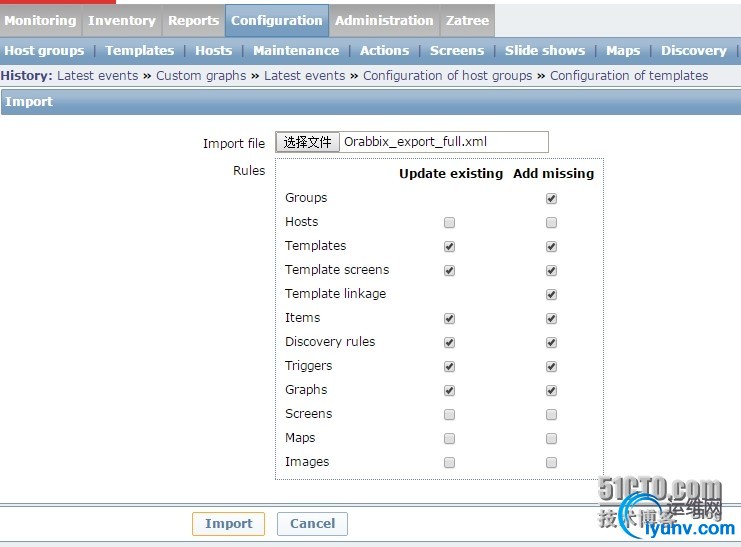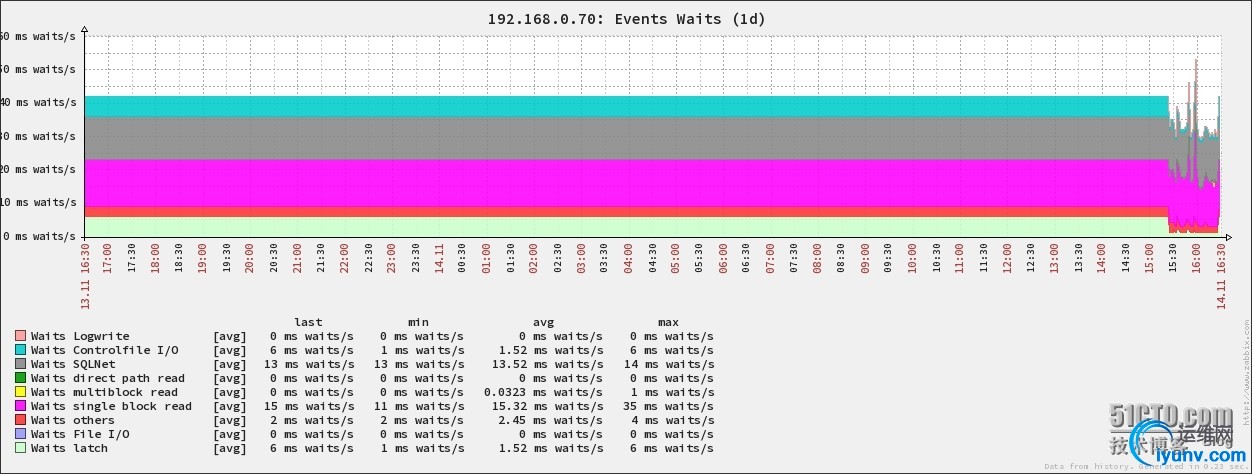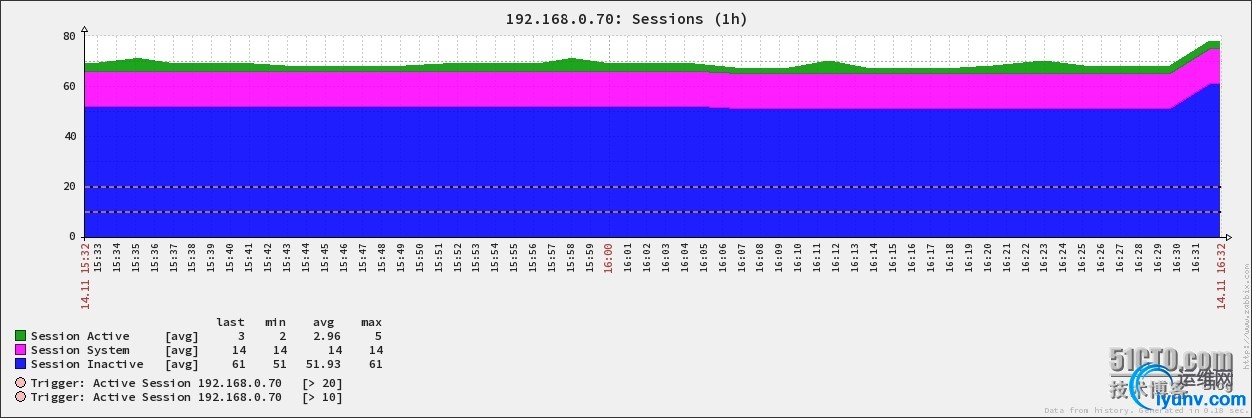|
一、简介 Orabbix 是设计用来为 zabbix 监控 Oracle 数据库的插件,它提供多层次的监控,包括可用性和服务器性能指标。 它提供了从众多 Oracle 实例采集数据的有效机制,进而提供此信息的监控和性能指标。然后,您可以利用的 zabbix 的报告功能为收集的所有数据,并提供分析。目前的发行版中包含了一组预先定义的模板,包括从初始部署警报和图形功能。然而,这些可以进行微调,以满足您的需求和数据/监控要求。
Orabbix 监控什么? - 数据库版本
- 归档日志与生产趋势分析
- 触发器,表/过程等命中率
- 逻辑 I/O 性能
- 物理 I/O 性能
- PGA
- SGA
- 共享池
- Sessions
- 数据库大小
二、安装配置 # mkdir /opt/orabbix # cd /opt/orabbix # unzip orabbix-1.2.3.zip # mvconf/config.props.sample conf/config.props # cp init.d/orabbix /etc/init.d/ # chmod 755 /etc/init.d/orabbix # chkconfig orabbix on
三、修改 orabbix 配置 # vim conf/config.props #comma separed list of Zabbix servers ZabbixServerList=ZabbixServer ZabbixServer.Address=192.168.0.180 ZabbixServer.Port=10051 #pidFile OrabbixDaemon.PidFile=./logs/orabbix.pid #frequency of item's refresh OrabbixDaemon.Sleep=300 #MaxThreadNumber should be >= thanthe number of your databases OrabbixDaemon.MaxThreadNumber=100 #put here your databases in a commaseparated list DatabaseList=192.168.0.70 # 名称与该机在 zabbix 中监控的主机名称保持一致 #Configuration of Connection pool #if not specified Orabbis is going touse default values (hardcoded) #Maximum number of active connectioninside pool DatabaseList.MaxActive=10 #The maximum number of milliseconds thatthe pool will wait #(when there are no availableconnections) for a connection to be returned #before throwing an exception, or <=0 to wait indefinitely. DatabaseList.MaxWait=100 DatabaseList.MaxIdle=1 #define here your connection string foreach database 192.168.0.70.Url=jdbc:oracle:thin:@192.168.0.70:32778:southdb # 需要 jdk 环境,因为这里是通过 JDBC 连接的,southdb 为数据库实例名称 192.168.0.70.User=ZABBIX # 用来监控 oracle 数据库的用户名和密码,需要在 oracle 中创建并赋予一定的权限 192.168.0.70.Password=ZABBIX #Those values are optionals if notspecified Orabbix is going to use the general values 192.168.0.70.MaxActive=10 192.168.0.70.MaxWait=100 192.168.0.70.MaxIdle=1 192.168.0.70.QueryListFile=./conf/query.props #DB2.Url=jdbc:oracle:thin:@server2.domain.example.com::DB2 #DB2.User=zabbix #DB2.Password=zabbix_password #DB2.QueryListFile=./conf/query.props #DB3.Url=jdbc:oracle:thin:@server3.domain.example.com::DB3 #DB3.User=zabbix #DB3.Password=zabbix_password #DB3.QueryListFile=./conf/query.props
关于 jdbc: Oracle = jdbc:oracle:thin:@:: PostgreSQL = jdbc:postgresql://:/ MS Sql Server = jdbc:jtds:sqlserver://:/ MySQL Server = jdbc:mysql://[host:port],[host:port].../[database] DB2 = jdbc:db2://:/
四、创建 oracle 监控账户 1、登录 oracle 命令行 su - oracle # 切换到 oracle 用户 sqlplus /nolog # 不连接任何数据库 conn /as sysdba # 用sysdba 登陆 或 conn 用户名/密码 select instance_name from v$instance; # 查看实例
2、创建用户 CREATE USER ZABBIX IDENTIFIED BY ZABBIX DEFAULT TABLESPACE SYSTEM TEMPORARY TABLESPACE TEMP PROFILE DEFAULT ACCOUNT UNLOCK;
3、赋予角色权限
GRANT CONNECT TO ZABBIX; GRANT RESOURCE TO ZABBIX; ALTER USER ZABBIX DEFAULT ROLEALL;
4、赋予系统权限
GRANT SELECT ANY TABLE TOZABBIX; GRANT CREATE SESSION TO ZABBIX; GRANT SELECT ANY DICTIONARY TOZABBIX; GRANT UNLIMITED TABLESPACE TOZABBIX; GRANT SELECT ANY DICTIONARY TOZABBIX;
五、启动服务
/etc/init.d/orabbix start 或 /opt/orabbix/run.sh
在启动服务过程中通过 tail -f /opt/orabbix/logs/orabbix.log日志查看报错信息。
六、zabbix server 端配置
将该模板 Orabbix_export_full.xml 下载到本机,差导入 zabbix server template
# sz orabbix/template/Orabbix_export_full.xml

将模板绑定到要监控的主机上:


附:官方文档 http://www.smartmarmot.com/wiki/index.php/Orabbix Assumptions Theinstallation instructions have been created based on instructions for most *nixdeployments (i.e. RHEL/CentOS), and is assumed that any alterations requiredfor your specific environment are to be taken into account accordingly. Thisguide is based upon there being two (2) Hosts, 1x Zabbix Server and 1x OracleServer. If you are planning on monitoring an Oracle instance that is running onyour Zabbix Server, the steps are the same, with minor adjustments required foryour connection information. Thesteps also assume you are configuring Orabbix to monitor a new installation orsetup of Oracle. The installation steps will have you GRANT access for theZabbix user to all tables, and this will include any USER tables present at thetime of execution. If you do not want Zabbix to have access to specific tablesor resources within your database, you will need to set a DENY to the Zabbixusers access as required. Consult your DBA for details, as this is beyond thescope of these instructions. Stepsfor Installation - Download Orabbix to your Zabbix Server
- On your Zabbix server, unzip Orabbix to: /opt/orabbix
- Copy file /opt/orabbix/init.d/orabbix to /etc/init.d/orabbix
- Grant execute permissions to the following files:
/etc/init.d/orabbix /opt/orabbix/run.sh - Create a User (ZABBIX) for Orabbix to access your Oracle Database. You can use the following script:
CREATE USER ZABBIX IDENTIFIED BY ZABBIX DEFAULT TABLESPACE SYSTEM TEMPORARY TABLESPACE TEMP PROFILE DEFAULT ACCOUNT UNLOCK;
– 2 Roles for ZABBIX GRANT CONNECT TO ZABBIX; GRANT RESOURCE TO ZABBIX; ALTER USER ZABBIX DEFAULT ROLE ALL;
– 5 System Privileges for ZABBIX GRANT SELECT ANY TABLE TO ZABBIX; GRANT CREATE SESSION TO ZABBIX; GRANT SELECT ANY DICTIONARY TO ZABBIX; GRANT UNLIMITED TABLESPACE TO ZABBIX; GRANT SELECT ANY DICTIONARY TO ZABBIX;
- NOTE if you need an User (ZABBIX) for Orabbix with the minimum grants available, you can use the following script:
CREATE USER ZABBIX IDENTIFIED BY ZABBIX DEFAULT TABLESPACE USERS TEMPORARY TABLESPACE TEMP PROFILE DEFAULT ACCOUNT UNLOCK; GRANT ALTER SESSION TO ZABBIX; GRANT CREATE SESSION TO ZABBIX; GRANT CONNECT TO ZABBIX; ALTER USER ZABBIX DEFAULT ROLEALL; GRANT SELECT ON V_$INSTANCE TOZABBIX; GRANT SELECT ON DBA_USERS TOZABBIX; GRANT SELECT ON V_$LOG_HISTORYTO ZABBIX; GRANT SELECT ON V_$PARAMETER TOZABBIX; GRANT SELECT ON SYS.DBA_AUDIT_SESSIONTO ZABBIX; GRANT SELECT ON V_$LOCK TOZABBIX; GRANT SELECT ON DBA_REGISTRY TOZABBIX; GRANT SELECT ON V_$LIBRARYCACHETO ZABBIX; GRANT SELECT ON V_$SYSSTAT TOZABBIX; GRANT SELECT ON V_$PARAMETER TOZABBIX; GRANT SELECT ON V_$LATCH TOZABBIX; GRANT SELECT ON V_$PGASTAT TOZABBIX; GRANT SELECT ON V_$SGASTAT TOZABBIX; GRANT SELECT ON V_$LIBRARYCACHETO ZABBIX; GRANT SELECT ON V_$PROCESS TOZABBIX; GRANT SELECT ON DBA_DATA_FILESTO ZABBIX; GRANT SELECT ON DBA_TEMP_FILESTO ZABBIX; GRANT SELECT ON DBA_FREE_SPACETO ZABBIX; GRANT SELECT ON V_$SYSTEM_EVENTTO ZABBIX;
NOTE : If you are using Oracle 11g, you will need to add the following: exec dbms_network_acl_admin.create_acl(acl=> 'resolve.xml',description => 'resolve acl', principal =>'ZABBIX',is_grant => true, privilege => 'resolve'); exec dbms_network_acl_admin.assign_acl(acl=> 'resolve.xml', host =>'*'); commit;
Youcan verify the above is correct by running: select utl_inaddr.get_host_name('127.0.0.1')from dual; - For this example on RedHat, run:
chkconfig -add orabbix chkconfig -list - Create a Host entry in Zabbix for the DB Instance/s you are planning to monitor, and import the templates found at: /opt/orabbix/template
Please note, instructions for this step can befound in the Zabbix Manual at With this step, ensure the name of yourhost in Zabbix is the same name of the SID or Oracle instance name. Configuration Nowwe need to configure your Orabbix setup. The tags below are listed as they willappear within the respective configuration files. The first you will need tomodify is your config.props file to define your connection properties forZabbix and Oracle. config.props Theconfig.props file can be found at /opt/orabbix/conf/config.props ZabbixServerList #comma separed list of Zabbix servers Thesettings under this tag allow you to configure your Zabbix Server information.Orabbix can also be configured to send your Oracle data to multiple Zabbixservers. This can be beneficial for distributedmonitoring scenarios, server migrations or replicating Orabbix data to a Disaster Recovery site or server. Replacewith your Zabbix Server info where appropriate; ZabbixServerList=ZabbixServer1,ZabbixServer2 ZabbixServer1.Address=192.168.0.1 ZabbixServer1.Port=10051
ZabbixServer2.Address=192.168.0.2 ZabbixServer2.Port=10051 OrabbixDaemon Entriesunder this tag allow you to set your Orabbix Daemon parameters. #MaxThreadNumber should be >= than thenumber of your databases Setthe number of threads the Orabbix Daemon should have inside his internal poolof DB Jobs. This number should be at least equal to (or more than) then numberof databases monitored by Orabbix, now this parameter if not set isautomatically calculated. e.g.For 50 Databases, we are using 100 threads OrabbixDaemon.MaxThreadNumber=100 #pidFile Nextyou can set the location of the Daemons PID file. Default location is:/opt/orabbix/logs OrabbixDaemon.PidFile=./logs/orabbix.pid NOTE: Relative path is permitted here TIP: With the features of the OrabbixDaemon, it is possible to clone Orabbix and use different configurations. As such, it is therefore possible to haveone Daemon that checks your TEST databases, another iteration that checks your DEVELOPMENT databases and a third thatchecks your PRODUCTION databases, each with different timings and check loops! DatabaseList
Thisis where you define your database instances. You can specify more than oneinstance here, separated using a comma. DatabaseList=EXAMPLE1,EXAMPLE2 NOTE: The names of the instances must match those you have specified asyour HOST name in Zabbix #Configuration of Connection pool Fromhere, you will configure settings that are specific to the connection pool. Asthe comments in config.props suggest, if you do not specify these values,Orabbix will use default values which have been hard-coded. #Maximum number of active connection insidepool Setthe maximum number of connections that can be allocated to this pool at anytime,or alternatively set a negative value for no limit. DatabaseList.MaxActive=10 #The maximum number of milliseconds Hereyou define how long that the pool will wait (when there are no available connections)for a connection to be returned before throwing an exception, or set the value<= 0 to wait indefinitely. DatabaseList.MaxWait=100 Alsounder the same section, you can define the maximum number of connections thatcan remain idle within the connection pool, without being released.Alternatively, you can set a negative value for no limit. DatabaseList.MaxIdle=1 TIP: You can specify the Database connection parameters for each database youwish to monitor individually, underneath your Database Connection Parameters.This allows you to customise your connection settings based on the Databaseconstraints I.e one connection pool for your PRODUCTION DB and another for youTEST DB, for example; DB1.MaxActive=10 DB1.MaxWait=100 DB1.MaxIdle=1 Notethat any settings defines this way will override the general settings for yourgeneric connection pool. Database Connection Parameters Thissection sets your connection string to the Oracle Database. This string invokesa Java Database Connector (JDBC) to your Oracle Databases, and as such does notneed the Oracle Client to be installed. #define here your connection string for eachdatabase Hereyou will define the connection string. These are formatted as: DBName.Url(asspecified in your DatabaseList) followed by the jdbc string and your DatabaseServer information. EXAMPLE1.Url=jdbc:oracle:thin:@SERVER1.EXAMPLE.COM:1521:DB1 Setyour Database username and password below. e.g. EXAMPLE1.User=zabbix EXAMPLE1.Password=zabbix_password TIP: Setting connections to multiple databases is made easy by adding moreconnection strings, with their corresponding credentials. Example given below. EXAMPLE2.Url=jdbc:oracle:thin:@server2.domain.example.com::EXAMPLE2 EXAMPLE2.User=zabbix EXAMPLE2.Password=zabbix_password EXAMPLE3.Url=jdbc:oracle:thin:@server3.domain.example.com::EXAMPLE3 EXAMPLE3.User=zabbix EXAMPLE3.Password=zabbix_password NOTE:After these entries, you can set your MaxActive, MaxWait and MaxIdle forthe individual database connections if you so wish. Thereis a pair of default parameter: DefaultUser = DefaultPassword = thisdefault parameter can be overridden using the following pair .User and .User Itis only possible to override Username or Password. Query List File Thisdefines where the file containing the Oracle (SQL) queries can be found. Thisis a customisable file. You can find the query parameter file at: QueryListFile=/opt/orabbix/conf/query.props youcan also specify : .QueryListFile=./confQueryTest.propsthis file specify the query file of adatabase relative path are allowed TIP: This is really useful to use different query file for differentdatabases or to have a pool of query file one for each OracleRelease (if you have different release) and/or to have different query filesfor Production environment, Test environment, Developement environment etc.. thefollowing parameter .ExtraQueryListFile==./confQueryTest_2.props addsanother custom query to the default query file. If there are duplicates theExtraQueryListFile will override them. query.props Configurationof query.props file Thequery.props file can be modified or added to, so you can supply your owncustomised queries through Orabbix against your Oracle instances/databases.Each query created has an associated 'Item' or item name that Zabbix will useto identify the query. NOTE: Item names must be unique. Theconfigurable items are formatted as follows.
Youhave to set the query name under the QueryList in the query.props file. Eachquery name is comma separated. For example; QueryList=queryName1,queryName2,queryName3
Youmust identify the query by the unique item name you specified in the QueryList,followed by '.Query' for Orabbix to recognize that this is the query string.Its important to remember NOT to add the semi-colon “;”to the end of your custom query. customQueryItemName.Query=yourQueryHere Nowyou can define what you want Orabbix to return to your Zabbix Server if no datais found for your query. customQueryItemName.NoDataFound=none TIP: In the example above, Orabbix would send the string “none”to the Zabbix Server. Youcan specify if you want a different execution period for your query customQueryItemName.Period= TIP:You can change the execution time of dbversion that don’t change often Nextyou can specify a query that will be executed and if return RaceCondiftionValuethe query customQueryItemName is executed otherwise is skipped customQueryItemName.ACTIVE=[true|false] iftrue query is executed otherwise skipped
archive.Query=select round(A.LOGS*B.AVG/1024/1024/10 ) from ( SELECT COUNT (*) LOGS FROM V$LOG_HISTORYWHERE FIRST_TIME >= (sysdate -10/60/24)) A, ( SELECT Avg(BYTES) AVG, Count(1), Max(BYTES) Max_Bytes,Min(BYTES)Min_Bytes FROM v$log) B archive.RaceConditionQuery=select value from v$parameter where name='log_archive_start' archive.RaceConditionValue=FALSE TIP:In the example above, Orabbix would execute “archive.Query”only if the query “archive.RaceConditionQuery” return the value “archive.RaceConditionValue”. Pratically the “Archive”query is execute only if database is in arhivelogmode (Parameter “log_archive_start” set to TRUE) .Trim=[true|false] iftrue the resultset is trimmed (default is true) .AddSpaces=[true|false] iftrue the add a space between columns of resultset(default is true) .ExcludeColumnsList=[1,2,3,..n] excludefrom result set the 1st, the 2nd etc.. columns from resultset .Period .WhenNotAlive = isused to specify a value or a string to send if a database is not working, doingsuch will "clean" the graphs generated in Zabbix with a"set" value.
Addedthe following parameter on main configuration file: DefaultUser = DefaultPassword = .ExtraQueryListFile =
onquery's properties file I've added the following parameter: .WhenNotAlive = withthese parameter you can define a default username and password for all thedatabase. DefaultUser = DefaultPassword = thisdefault parameter can be overridden using the couple .User and .User Ispossible to override only Username or Password. thefollowing parameter .ExtraQueryListFile = addanother custom query to a default query file. if there are duplicate theExtraQueryListFile will override them. thefollowing parameter .WhenNotAlive = isused to specify a value or a string to send if a database is not working, doingso you are going to "clean" the graphs generated in Zabbix with a"set" value. Howto Use Orabbix/FAQ How do I start/stop the Daemon? Tostart the Orabbix Daemon, simply run: /etc/init.d/orabbix start
Tostop the Orabbix Daemon, simply run: /etc/init.d/orabbix start
How does Logging work? TheOrabbix daemon outputs its log file to the default location of/opt/orabbix/logs/ How to modify Log format? Loggingproperties can be modified by making your required changes to /opt/orabbix/conf/log4j.properties Theproperty setting responsible for defining the output location is: log4j.appender.Orabbix.File=logs/orabbix.log Is there a way for orabbix to connect to RAC or DataGuard? Yesis possible. e.g. Ifyou have two host RAC1 and RAC2 and one instance RACINST youshould write the connection string as follow: RACINST.Url=jdbc:oracle:thin:@(DESCRIPTION=(ADDRESS_LIST=(ADDRESS=(PROTOCOL=TCP)(HOST=RAC1.EXAMPLE.COM) (PORT=1521))(ADDRESS=(PROTOCOL=TCP)(HOST=RAC2.EXAMPLE.COM)(PORT=1521)))(CONNECT_DATA=(SERVICE_NAME=RACINST))) Whatcan I modify without restarting the daemon? Theparameters that are dynamically read at each iteration of “OrabbixDaemon.Sleep” are as follows; - Any Query added to query.props
- Modifications to config.props
- Database List
Currently,the only known items that don't dynamically update are theZabbixDaemon.MaxThreadNumber, and changes to Connection Pool info.
|